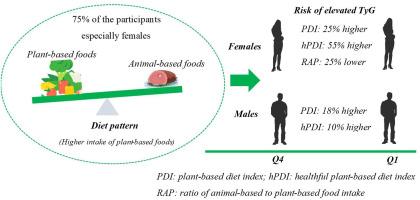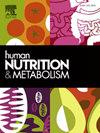在饮食模式不平衡的情况下,TyG水平升高与植物性饮食的关系
IF 1.8
Q3 ENDOCRINOLOGY & METABOLISM
引用次数: 0
摘要
目的不平衡条件下植物性饮食对健康的影响尚不清楚。我们调查了中国人群中植物性饮食与甘油三酯-葡萄糖指数(TyG)的关系。方法数据来源于中国西北地区民族队列研究。采用半定量食物频率问卷收集膳食数据,建立植物性饮食指数(PDI)、健康植物性饮食指数(hPDI)和不健康植物性饮食指数(uPDI) 3个指标。引入了一个新的指标来表示动物性食物与植物性食物的摄取量比(RAP和健康RAP)。采用logistic回归和限制三次样条模型评价各植物性日粮指标与TyG的关系。结果超过75%的参与者坚持高摄入植物性食物的饮食。与男性相比,女性食用的植物性食物更多,动物性食物更少。在女性中,PDI(OR = 1.25, 95% CI: 0.97-1.62)和hPDI(OR = 1.55, 95% CI: 1.19-2.03) Q4的女性与最低四分位数的女性相比,TyG升高的风险增加。高TyG水平和PDI之间有显著的关联,除了男性的hPDI。在第4季度有RAP的女性中,与第1季度有RAP的女性相比,TyG升高的风险降低了25% (OR = 0.75, 95% CI: 0.60-0.95), RAP值小于1的女性中效果更明显。hRAP也有类似的趋势。结论:中国北方人经常食用植物性食物,坚持植物性饮食与TyG水平升高的风险相关。相反,食用更多的动物性食物可能会减轻女性的这种风险,这凸显了保持均衡饮食的重要性。本文章由计算机程序翻译,如有差异,请以英文原文为准。

Association of elevated TyG level with plant-based diets in the context of imbalanced dietary pattern
Objective
The health impact of plant-based diets under imbalanced conditions remains unclear. We investigated the association of plant-based diet with Triglyceride-glucose index(TyG) among Chinese population.
Methods
Data were obtained from the Regional Ethnic Cohort Study in northwest China. Dietary data collected with a semi-quantitative food frequency questionnaire was used to establish three indices: plant-based diet index(PDI), healthy plant-based diet index(hPDI), and unhealthy plant-based diet index(uPDI). A new index was introduced to represent ratio of animal-based to plant-based food intake(RAP and healthy RAP). The relationships between each plant-based diet index and TyG was assessed with logistic regression and restricted cubic spline model.
Results
Over 75 % of participants adhered to a diet with higher intake of plant-based foods. Females consumed more plant-based foods and fewer animal-based foods than their male counterparts. Among females, those in Q4 of PDI(OR = 1.25,95 %CI:0.97–1.62) and hPDI(OR = 1.55,95 %CI:1.19–2.03) faced an increased risk of higher TyG compared to those in the lowest quartile. A significant association between higher TyG levels and the PDI was observed, except hPDI for males. In females with RAP in Q4, the risk of elevated TyG decreased by 25 %(OR = 0.75,95 %CI:0.60–0.95) compared to those with RAP in Q1, with a more pronounced effect noted among females with RAP values less than one. A similar trend was observed for hRAP.
Conclusion
People in Northern China often consume plant-based foods, and adherence to a plant-based diet is associated with risk of elevated TyG levels. Conversely, a higher consumption of animal-based foods may mitigate this risk among women, highlighting the importance of maintaining a balanced diet.
求助全文
通过发布文献求助,成功后即可免费获取论文全文。
去求助
来源期刊

Human Nutrition and Metabolism
Agricultural and Biological Sciences-Food Science
CiteScore
1.50
自引率
0.00%
发文量
30
审稿时长
188 days
 求助内容:
求助内容: 应助结果提醒方式:
应助结果提醒方式:


